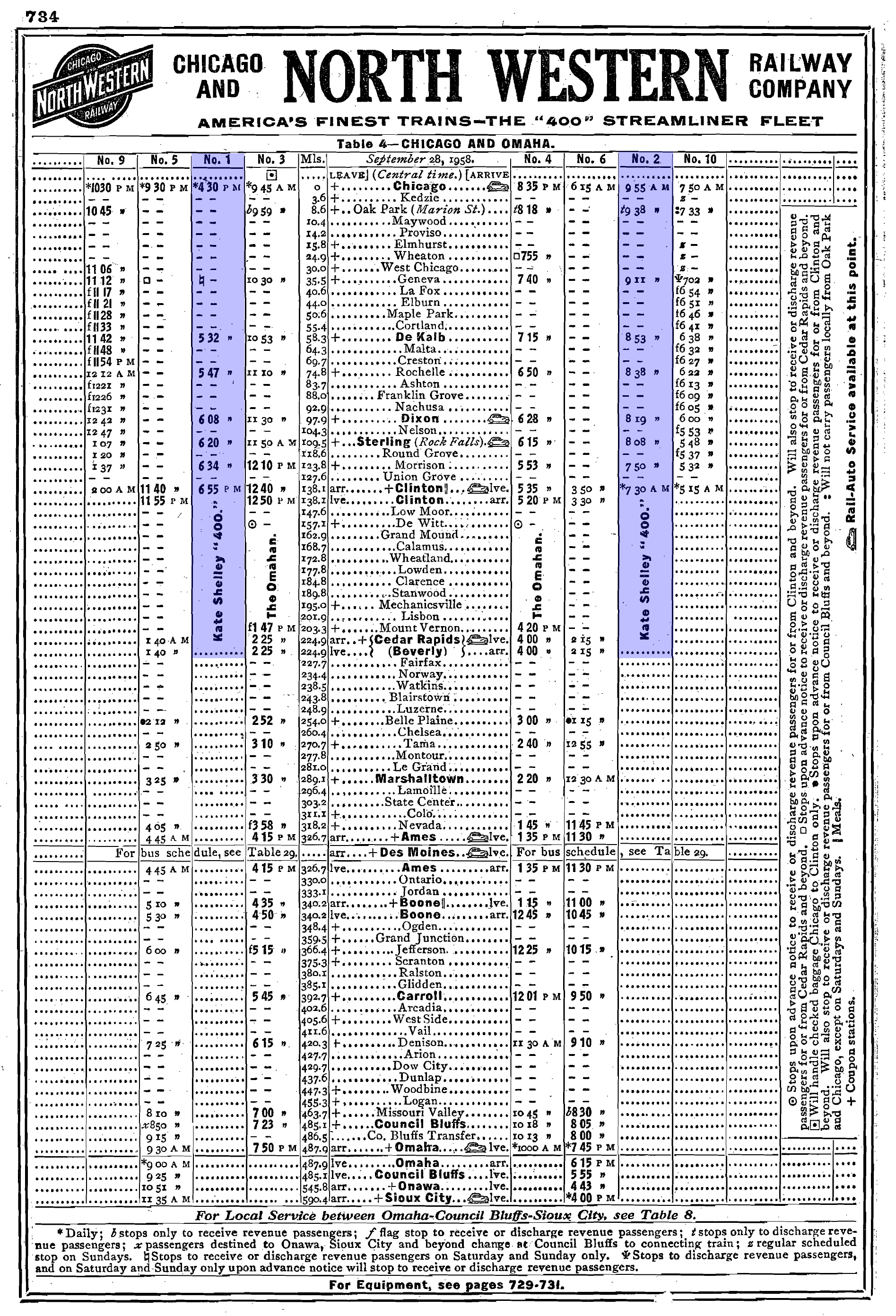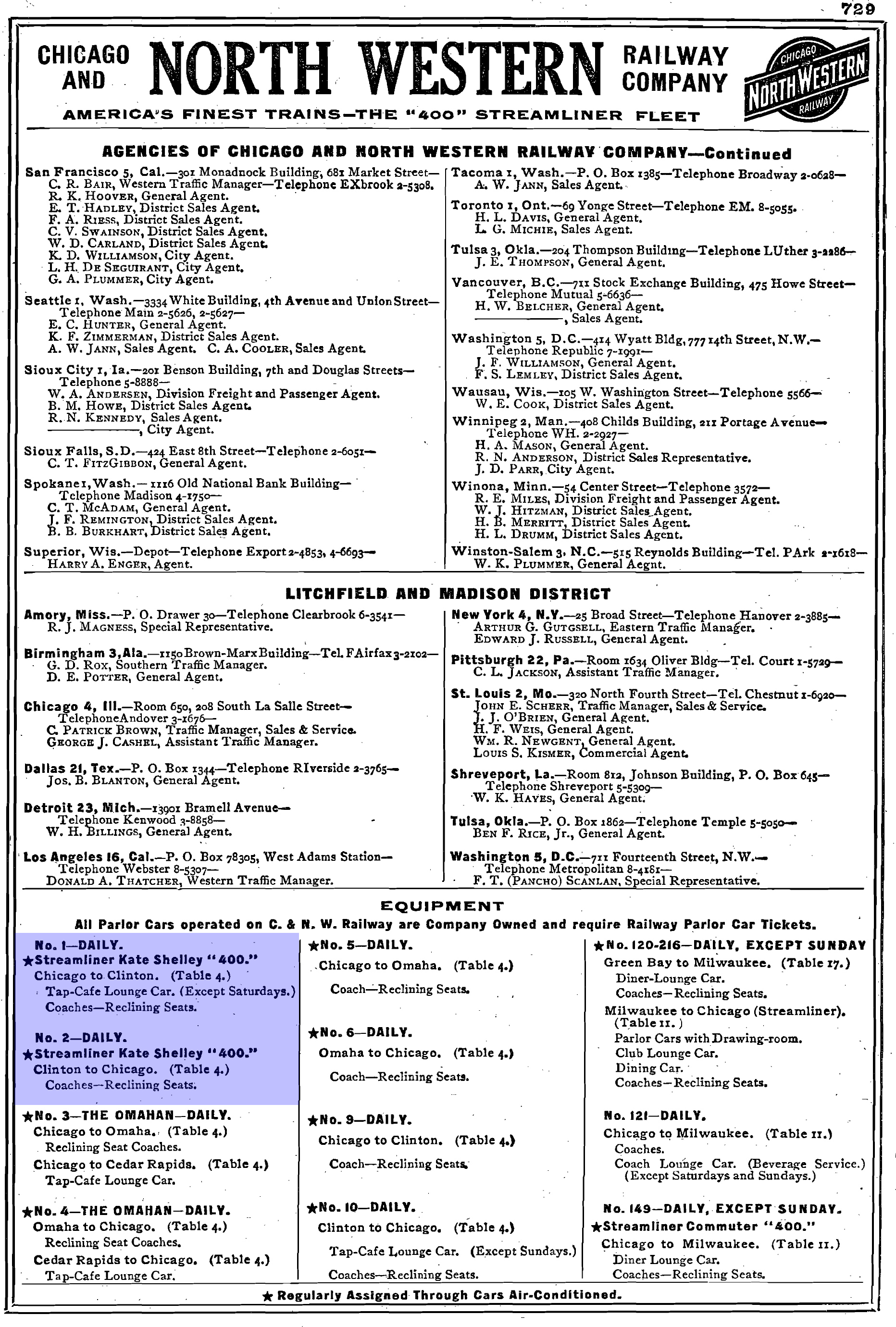"Kate Shelley '400'" (Train): Consist, Timetable, Photos
Last revised: September 12, 2024
By: Adam Burns
The Kate Shelley 400 was a very late addition to the Chicago & North Western's family of streamliners. The train was brought about by the loss of through service with Union Pacific's City fleet, which had switched to the Milwaukee Road in 1955 for its Chicago connection.
The Kate Shelley, named after a railroad heroine who saved a passenger train from a grim fate during the late 19th century, allowed the C&NW to continue providing service along its Omaha main line where it ran as far as Boone, Iowa when it first entered service.
Unfortunately, the train's initial routing was short-lived as it was soon cutback although it remained on the timetable, albeit as an unnamed run during its final years, until the start of Amtrak during the spring of 1971.
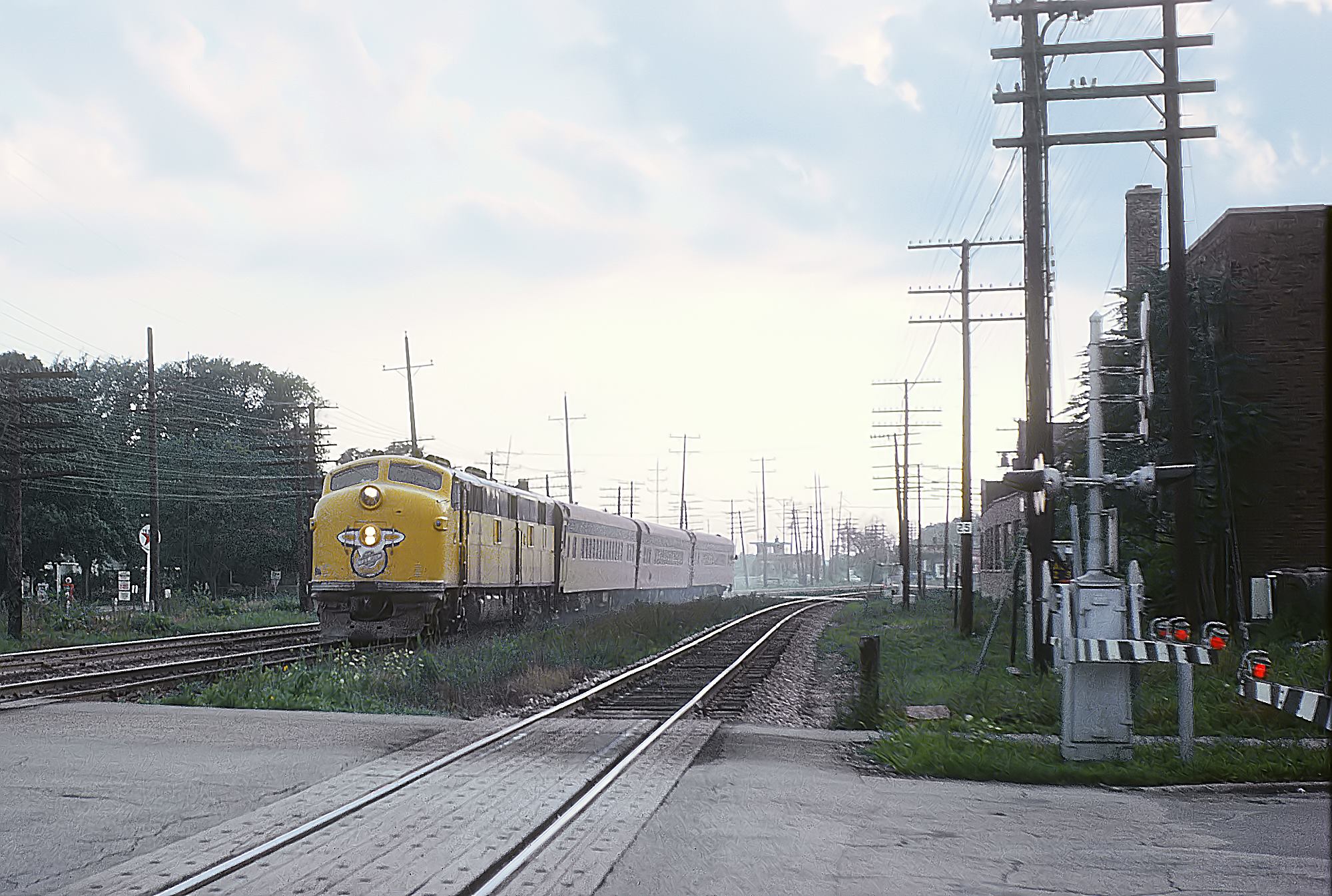 Chicago & North Western's train #12 the "Kate Shelley 400," hustles through Wheaton, Illinois in August, 1963. Monday through Saturday the train was numbered 1 and 2. However, on Sunday, with a somewhat different schedule, it was 11 and 12. Rick Burn photo.
Chicago & North Western's train #12 the "Kate Shelley 400," hustles through Wheaton, Illinois in August, 1963. Monday through Saturday the train was numbered 1 and 2. However, on Sunday, with a somewhat different schedule, it was 11 and 12. Rick Burn photo.Since 1889 the 'North Western and Union Pacific had been working together closely to provide passengers service from Chicago to points across the West.
During the early years this included (UP) trains like the Overland Flyer (Chicago - Portland with connections to San Francisco) and Los Angeles Limited (Chicago - Los Angeles). On June 6, 1935 their transcontinental operations witnessed a significant upgrade when lightweight, diesel-powered trainsets were launched beginning with the City of Portland (the M-100001).
Photos
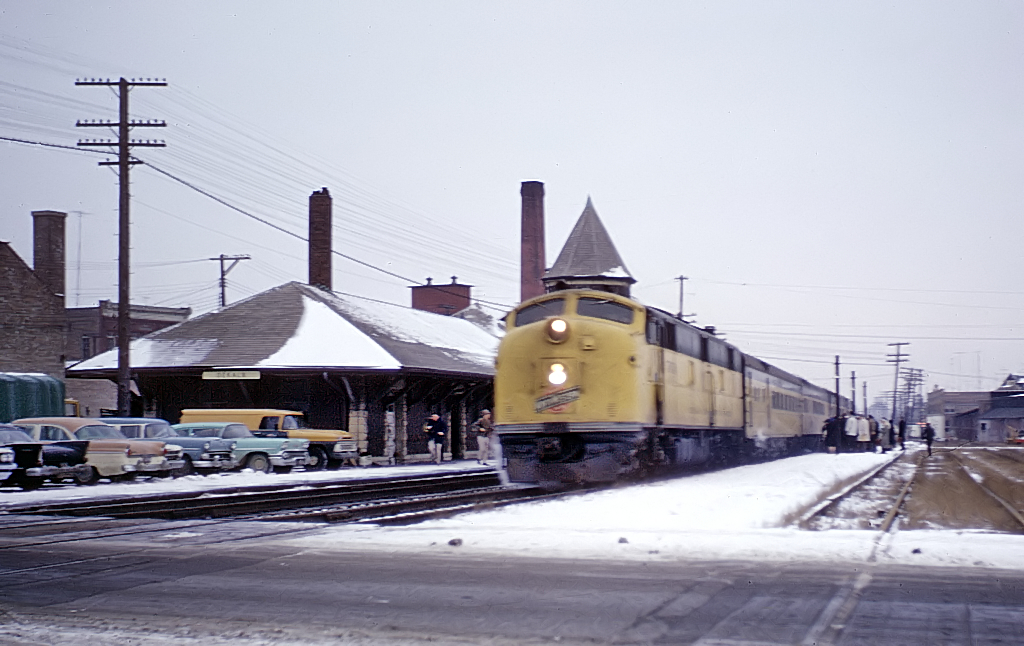 C&NW's train #2, the eastbound "Kate Shelley '400'," is stopped at DeKalb, Illinois in January, 1965. Rick Burn photo.
C&NW's train #2, the eastbound "Kate Shelley '400'," is stopped at DeKalb, Illinois in January, 1965. Rick Burn photo.History
This sleek new streamliner was soon followed by an entire fleet including the City of Los Angeles, City of San Francisco, and City of Denver.
The two railroads continued to partner for another twenty years until 1955 when UP became disenchanted with the C&NW's service and switched to the Milwaukee Road beginning on October 30th.
This left the 'North Western with no through, passenger trains along its Omaha main line leading to the inauguration of the Kate Shelley 400 between Chicago and Boone, Iowa.
At A Glance
1 (westbound) 2 (eastbound) | |
North Western Terminal (Chicago) Boone, Iowa Depot |
|
The train was named after Catherine "Kate" Shelley, an Irish immigrant who came to the United States soon after she was born and eventually settled in Boone County, Iowa.
She lived a quiet life for many years until July 6, 1881 when she heard a C&NW train crash into nearby Honey Creek (a single locomotive out checking track conditions), the result of flash floods caused by the day's severe thunderstorms.
Knowing that an eastbound passenger train would be passing through the area soon, Shelley rushed on foot and through bad weather to the local Moingona depot to warn of the washout and wrecked locomotive.
Timetable (1958)
Her heroic efforts saved the passenger train from impending disaster and led to the rescue of two of the crew involved in the washout. She was praised by the railroad, local community, and eventually became a national heroine.
The 'North Western went on to name a bridge after her in 1900 (still in use albeit since rebuilt) as well as a new streamliner years later. The Kate Shelley 400 was listed as trains #1 (westbound) and #2 (eastbound) on the C&NW's timetable.
Its consist primarily included lightweight equipment featuring reclining seat coaches, a diner, lounges, and a parlor running a schedule of only a few hours from Chicago to Boone, 340 miles (as a dayliner, sleepers were not required). Initially, its equipment was made up of that formerly used on the City trains but this was later scattered throughout the 'North Western's fleet.
Consist (1958)
The Katy, as the train was also known by locals, was cutback to Cedar Rapids during August of 1956 and then a year later was truncated to Clinton, Iowa just 137 miles west of Chicago.
By 1961 the Kate Shelley 400 was the last named train still providing service on the 'North Western's Omaha line (running daily except Sunday) and after July 23, 1963 the name was quietly dropped altogether from the timetable. However, surprisingly the unnamed train continued to operate as a local, coach-only "streamliner" until the start of Amtrak on May 1, 1971.
As a fleet, the C&NW's famous 400s suffered a rather unglamorous fate as the 1950s gave way to the 1960s. By then the railroad was experiencing declining ridership all across its systems, and regional dayliners saw particularly sharp losses (only the Dakota 400 provided sleepers).
Timetable (July 16, 1969)
| Time/Leave (Train #1) | Milepost | Location | Time/Arrive (Train #2) |
|---|---|---|---|
| 5:00 PM | 0.0 | 8:55 AM | |
| 8.6 | 8:38 AM | ||
| 24.9 | |||
| 5:42 PM | 35.5 | 8:10 AM | |
| 6:12 PM | 58.3 | 7:35 AM | |
| 6:34 PM | 74.8 | 7:10 AM | |
| 7:02 PM | 97.9 | 6:40 AM | |
| 7:20 PM | 109.5 | 6:26 AM | |
| 7:37 PM | 123.8 | 6:10 AM | |
| 8:00 PM | 137.1 | 5:55 AM |
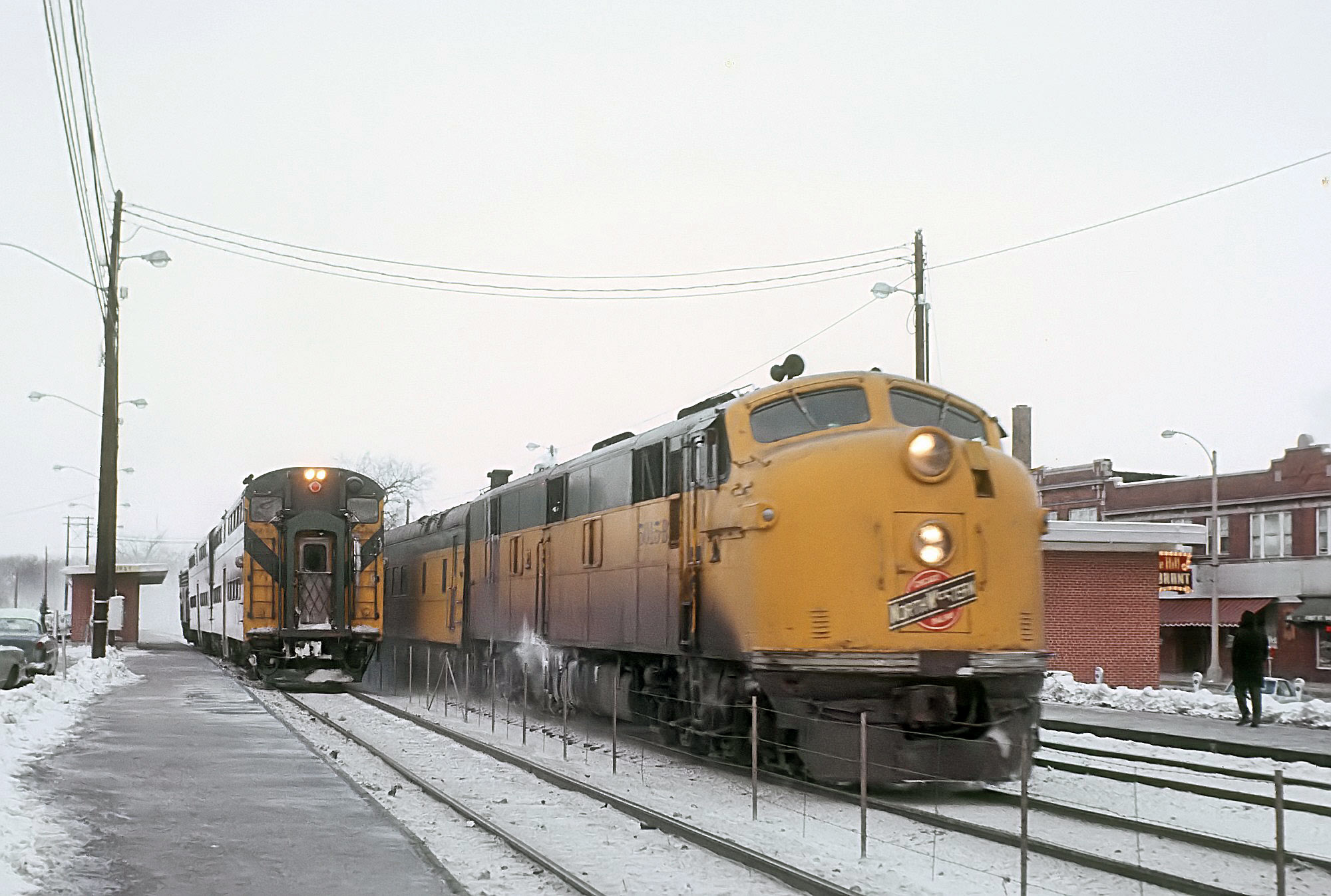 The C&NW's eastbound "Kate Shelley 400" meets an eastbound scoot at Elmhurst, Illinois; January, 1968. Rick Burn photo.
The C&NW's eastbound "Kate Shelley 400" meets an eastbound scoot at Elmhurst, Illinois; January, 1968. Rick Burn photo.Final Years
In an effort to curb rising costs the C&NW ended or reduced services where possible. For instance, in Wisconsin the railroad was able to eliminate 14 secondary trains by introducing bi-level, gallery cars but even this effort was only a short-term solution that wasn't able to stop the public from fleeing the rails for automobiles and airlines.
After the Katy lost its name the 'North Western dropped the 400 designation altogether during the late 1960s referring to its trains thereafter as merely "Streamliners" and marketing itself as the "Route Of The Streamliner."
When Amtrak began service the railroad had only a few scheduled trains still running reaching such locations as Green Bay, Clinton, Milwaukee, northern Wisconsin, and Michigan's Upper Peninsula (this, of course, did not include suburban Chicago commuter service).
Recent Articles
-
Kansas ~ Murder Mystery ~ Dinner Train Rides
Jan 21, 26 01:40 PM
Kansas, known for its sprawling wheat fields and rich history, hides a unique gem that promises both intrigue and culinary delight—murder mystery dinner trains. -
Florida ~ Murder Mystery ~ Dinner Train Rides
Jan 21, 26 01:05 PM
Florida, known for its vibrant culture, dazzling beaches, and thrilling theme parks, also offers a unique blend of mystery and fine dining aboard its murder mystery dinner trains. -
New Hampshire ~ Murder Mystery ~ Dinner Train Rides
Jan 21, 26 12:07 PM
The state's murder mystery trains stand out as a captivating blend of theatrical drama, exquisite dining, and scenic rail travel. -
New Jersey Dinner Train Rides In Woodstown
Jan 21, 26 11:20 AM
For visitors who love experiences (not just attractions), Woodstown Central’s dinner-and-dining style trains have become a signature offering—especially for couples’ nights out, small friend groups, a… -
Montana's Dinner Train Rides Near Lewistown!
Jan 21, 26 10:40 AM
The Charlie Russell Chew Choo turns an ordinary rail trip into an evening event: scenery, storytelling, live entertainment, and a hearty dinner served as the train rumbles across trestles and into a t… -
Kansas Valentine's Train Rides
Jan 21, 26 10:09 AM
While the railroad’s regular-season excursions are a big draw, the A&SV also shines with its calendar of themed trains—none more romantic than its Valentine’s Day special. -
Alabama Valentine's Train Rides
Jan 21, 26 09:39 AM
The Heart of Dixie Railroad Museum (HoDRM) is the kind of place where history isn’t parked behind ropes—it moves. This includes Valentine's Day weekend, where the museum hosts a wine pairing special. -
Wisconsin's Dinner Train Rides In North Freedom!
Jan 20, 26 01:55 PM
Featured here is a practical guide to Mid-Continent’s dining train concept—what the experience is like, the kinds of menus the museum has offered, and what to expect when you book. -
New York's Dinner Train Rides In The Adirondacks!
Jan 20, 26 12:41 PM
Operating over a restored segment of the former New York Central’s Adirondack Division, the Adirondack Railroad has steadily rebuilt both track and public interest in passenger rail across the region. -
Pennsylvania "Dinner Train" Rides In Boyertown!
Jan 20, 26 12:04 PM
With beautifully restored vintage equipment, carefully curated menus, and theatrical storytelling woven into each trip, the Colebrookdale Railroad offers far more than a simple meal on rails. -
New York ~ Murder Mystery ~ Dinner Train Rides
Jan 20, 26 12:03 PM
New York State, renowned for its vibrant cities and verdant countryside, offers a plethora of activities for locals and tourists alike, including murder mystery train rides! -
Pennsylvania ~ Murder Mystery ~ Dinner Train Rides
Jan 20, 26 11:48 AM
Pennsylvania, steeped in history and industrial heritage, offers a prime setting for a unique blend of dining and drama: the murder mystery dinner train ride. -
Florida Valentine's Train Rides
Jan 20, 26 11:46 AM
For couples looking for something different this Valentine’s Day, the museum’s signature romantic event is back: the Valentine Limited, returning February 14, 2026—a festive evening built around a tra… -
Connecticut Valentine's Train Rides
Jan 20, 26 11:43 AM
Operated by the Valley Railroad Company, the attraction has been welcoming visitors to the lower Connecticut River Valley for decades, preserving the feel of classic rail travel while packaging it int… -
Texas Dinner Train Rides At The TSR!
Jan 19, 26 12:30 PM
Today, TSR markets itself as a round-trip, four-hour, 25-mile journey between Palestine and Rusk—an easy day trip (or date-night centerpiece) with just the right amount of history baked in. -
Iowa's Dinner Train Rides In Boone!
Jan 19, 26 12:28 PM
If you’ve ever wished you could pair a leisurely rail journey with a proper sit-down meal—white tablecloths, big windows, and countryside rolling by—the Boone & Scenic Valley Railroad & Museum… -
Ohio Dinner Train Rides At The CVSR!
Jan 19, 26 12:27 PM
While the railroad is well known for daytime sightseeing and seasonal events, one of its most memorable offerings is its evening dining program—an experience that blends vintage passenger-car ambience… -
Missouri's Dinner Train Rides In Branson!
Jan 19, 26 12:21 PM
Nestled in the heart of the Ozarks, the Branson Scenic Railway offers one of the most distinctive rail experiences in the Midwest—pairing classic passenger railroading with sweeping mountain scenery a… -
Virginia Valentine's Train Rides
Jan 19, 26 12:15 PM
If you’ve ever wanted to slow life down to the rhythm of jointed rail—coffee in hand, wide windows framing pastureland, forests, and mountain ridges—the Virginia Scenic Railway (VSR) is built for exac… -
Maryland Valentine's Train Rides
Jan 19, 26 12:12 PM
The Western Maryland Scenic Railroad (WMSR) delivers one of the East’s most “complete” heritage-rail experiences: and also offer their popular dinner train during the Valentine's Day weekend. -
Indiana's Dinner Train Rides In Jasper!
Jan 18, 26 01:54 PM
In the rolling hills of southern Indiana, the Spirit of Jasper offers one of those rare attractions that feels equal parts throwback and treat-yourself night out: a classic excursion train paired with… -
New Mexico's Dinner Train Rides
Jan 18, 26 01:37 PM
If your heart is set on clinking glasses while the desert glows at sunset, you can absolutely do that here—just know which operator offers what, and plan accordingly. -
New Hampshire ~ Murder Mystery ~ Dinner Train Rides
Jan 18, 26 01:10 PM
The state's murder mystery trains stand out as a captivating blend of theatrical drama, exquisite dining, and scenic rail travel. -
New York Valentine's Train Rides
Jan 18, 26 12:32 PM
At its best, the Adirondack Railroad delivers exactly what railfans and casual riders alike hope for: vintage coaches, classic depots, rivers and forests right outside the window. -
Washington Valentine's Train Rides
Jan 18, 26 10:50 AM
Whether you’re a dedicated railfan chasing preserved equipment or a couple looking for a memorable night out, CCR&M offers a “small railroad, big experience” vibe—one that shines brightest on its spec… -
Colorado Valentine's Train Rides
Jan 18, 26 10:49 AM
The Royal Gorge Route Railroad is the kind of trip that feels tailor-made for railfans and casual travelers alike, including during Valentine's weekend. -
Georgia Valentine's Train Rides
Jan 18, 26 10:42 AM
f you’ve ridden the SAM Shortline, it’s easy to think of it purely as a modern-day pleasure train—vintage cars, wide South Georgia skies, and a relaxed pace that feels worlds away from interstates and… -
New Jersey ~ Murder Mystery ~ Dinner Train Rides
Jan 17, 26 01:16 PM
There are currently no murder mystery dinner trains available in New Jersey although until 2023 the Cape May Seashore Lines offered this event. Perhaps they will again soon! -
West Virginia Dinner Train Rides In Elkins!
Jan 17, 26 01:08 PM
The D&GV offers the kind of rail experience that feels purpose-built for railfans and casual travelers. -
Virginia Dinner Train Rides In Staunton!
Jan 17, 26 11:55 AM
If you’ve ever wished you could pair a classic scenic train ride with a genuinely satisfying meal—served at your table while the countryside rolls by—the Virginia Scenic Railway was built for you. -
Florida Easter Train Rides
Jan 17, 26 10:23 AM
The cold weather rarely invades Florida and the state nearly always warm and balmy early spring temperatures. Learn more about where you can find Easter-themed train rides across the Sunshine State. -
Ohio Easter Train Rides
Jan 17, 26 10:13 AM
Ohio is home to several museums and excursion trains preserving the state's rich railroading heritage. A few of these locations host Easter-themed train rides each spring. -
Massachusetts Valentine's Train Rides
Jan 17, 26 09:58 AM
The Cape Cod Central Railroad (CCCR) blends classic New England scenery with heritage equipment, narrated sightseeing, and some of the region’s best-known “rails-and-meals” experiences. -
California Valentine's Train Rides
Jan 17, 26 09:53 AM
Operating out of West Sacramento, this excursion railroad has built a calendar that blends scenery with experiences—wine pours, themed parties, dinner-and-entertainment outings, and seasonal specials… -
South Carolina Dinner Train Rides
Jan 16, 26 11:13 PM
There is only location in the Palmetto State offering a true dinner train experience can be found at the South Carolina Railroad Museum. Learn more here. -
Rhode Island Dinner Train Rides
Jan 16, 26 11:01 PM
Despite its small size, Rhode Island is home to one popular dinner train experience where guests can enjoy the breathtaking views of Aquidneck Island. -
Pennsylvania's Thomas The Train Rides
Jan 16, 26 04:13 PM
"A Day Out With Thomas” train rides offer a unique opportunity for children and their families to engage in a magical and memorable experience, setting the stage for a full day of fun and adventure. -
Illinois's Thomas The Train Rides
Jan 16, 26 02:23 PM
In Illinois, the "A Day Out With Thomas" event offers a unique chance for families to immerse themselves in the enchanting world of Thomas and friends, creating memories that last a lifetime. -
New Jersey's Thomas The Train Rides
Jan 16, 26 02:11 PM
Here's a comprehensive guide to what you can expect at Day Out With Thomas events in New Jersey. -
Texas ~ Murder Mystery ~ Dinner Train Rides
Jan 16, 26 01:54 PM
Here’s a comprehensive look into the world of murder mystery dinner trains in Texas. -
Connecticut ~ Murder Mystery ~ Dinner Train Rides
Jan 16, 26 01:26 PM
All aboard the intrigue express! One location in Connecticut typically offers a unique and thrilling experience for both locals and visitors alike, murder mystery trains. -
New Hampshire Dinner Train Rides In N. Conway!
Jan 16, 26 10:47 AM
Tucked into the heart of New Hampshire’s Mount Washington Valley, the Conway Scenic Railroad is one of New England’s most beloved heritage railways -
Oregon Dinner Train Rides Near Mt. Hood!
Jan 16, 26 10:44 AM
The Mt. Hood Railroad is the moving part of that postcard—a century-old short line that began as a working railroad. -
Maryland's - Wine Tasting - Train Rides
Jan 15, 26 02:59 PM
This article delves into the enchanting world of wine tasting train experiences in Maryland, providing a detailed exploration of their offerings, history, and allure. -
Colorado's - Wine Tasting - Train Rides
Jan 15, 26 02:46 PM
To truly savor these local flavors while soaking in the scenic beauty of Colorado, the concept of wine tasting trains has emerged, offering both locals and tourists a luxurious and immersive indulgenc… -
Iowa ~ Wine Tasting ~ Train Rides
Jan 15, 26 02:36 PM
The state not only boasts a burgeoning wine industry but also offers unique experiences such as wine by rail aboard the Boone & Scenic Valley Railroad. -
Georgia's Wine Train Rides In Cordele!
Jan 15, 26 02:26 PM
While the railroad offers a range of themed trips throughout the year, one of its most crowd-pleasing special events is the Wine & Cheese Train—a short, scenic round trip designed to feel like a t… -
Indiana ~ Murder Mystery ~ Dinner Train Rides
Jan 15, 26 02:22 PM
This piece explores the allure of murder mystery trains and why they are becoming a must-try experience for enthusiasts and casual travelers alike. -
Ohio ~ Murder Mystery ~ Dinner Train Rides
Jan 15, 26 02:10 PM
The murder mystery dinner train rides in Ohio provide an immersive experience that combines fine dining, an engaging narrative, and the beauty of Ohio's landscapes. -
Nevada Dinner Train Rides In Ely!
Jan 15, 26 02:01 PM
If you’ve ever wished you could step through a time portal into the hard-working world of a 1900s short line the Nevada Northern Railway in Ely is about as close as it gets.

